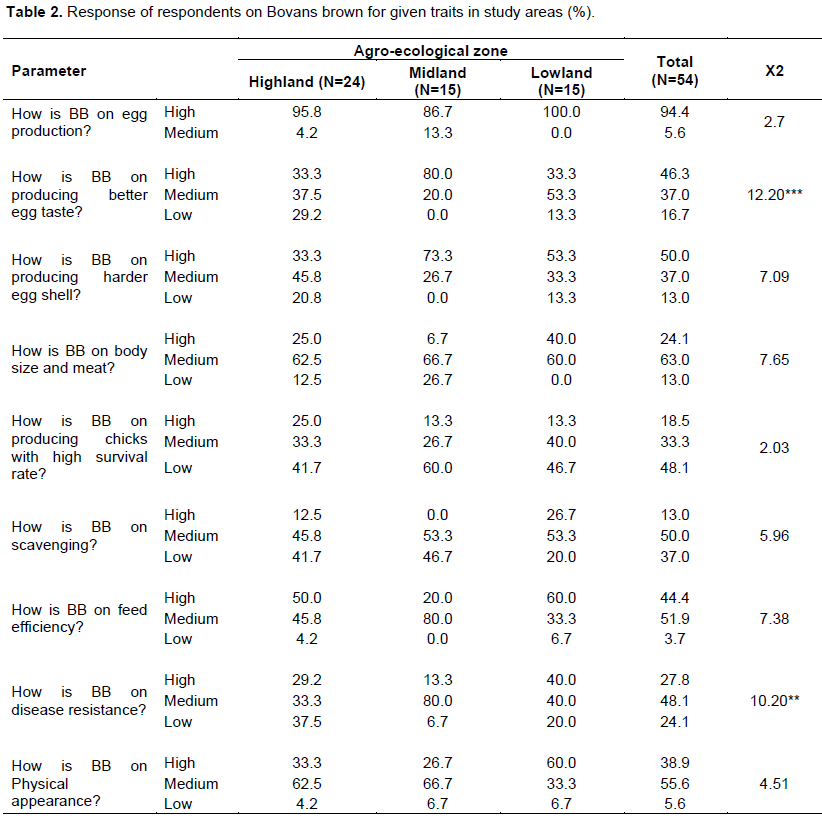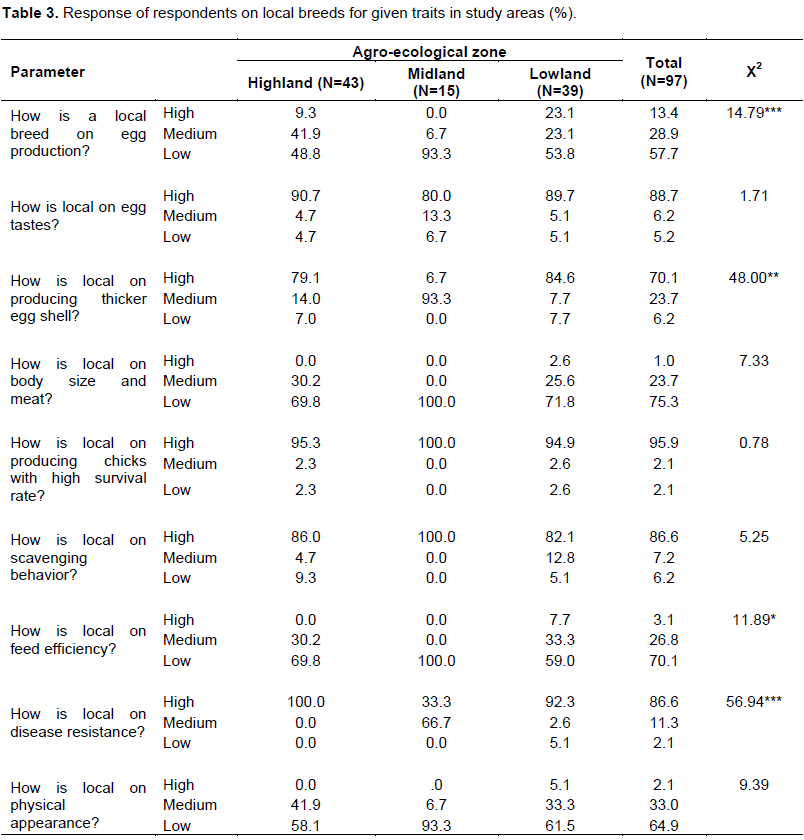ABSTRACT
A quick survey study was conducted with the objectives of assessing farmers trait preference and productive performance of Sasso provided by Ethio-chicken private poultry farms under village production system in three agro ecologies of SNNPR, Ethiopia. Totally, 135 randomly selected respondents (45 from each agro ecologies) were included in the study. The data collected were analyzed using descriptive statistics and one way ANOVA. According to the respondents most of the farmers were currently rearing more Sasso breeds in all agro ecologies (40.4, 72.7 and 47.7 in highland, midland and lowland respectively) than Bovans brown (17, 6.8 and 20.5% in highland, midland and lowland respectively). Current study exposed that 94.4% of respondents on average in all agro ecologies select Bovans brown for egg production while Sasso breed was selected by respondents (97.7%) for having large body size and producing high amount of meat. The information collected on age at first laying disclosed that the mean ages at first laying were 5.9±1.5, 5.7±1, and 7.1± 1.6 months for Sasso, Bovans brown and local breeds respectively. The result in the current study revealed that the average egg production per month of Bovans brown (22.2) is higher than that of Sasso (16.2) and local chickens (12.6). Most respondents repeatedly mentioned feed shortage as the first ranked chicken production constraint in all districts (25.4%) whereas predators (20.1%) were the second and disease was the third problem in overall agro ecologies though there were significant (p<0.05) differences among agro ecologies. To have a clear understanding of the performance of Sasso breeds of ethio-chicken private farms, on-farm and on-station controlled experiment on management practices and feeding strategy is important.
Key words: Sasso, agro ecologies, productive performances, trait preference.
Poultry production has an important economic, social and cultural benefit and plays a significant role in family nutrition in the developing countries. The proportional contribution of poultry to the total animal protein production of the world by the year 2020 is believed to increase to 40%, the major increase being in the developing world (Delgado et al., 1999). It has been estimated that 80% of the poultry population in Africa is found in traditional scavenging systems (Gueye, 2000). In most tropical countries it is based mainly on scavenging production systems, which makes substantial contributions to household food security throughout the developing world (Muchadeyi et al., 2007). Indigenous breeds still contribute meaningfully to poultry meat and egg production and consumption in developing countries, where they make up to 90% of the total poultry population. All over the developing world, these low-input, low output poultry-husbandry systems are an integral component of the livelihoods of most of rural, peri-urban, and some urban households and are likely to continue to meet this role for the foreseeable future (Besbes, 2009). Livestock production covers 40% of agricultural output in Ethiopia, playing an important role in the national economy as it contributes 18% of the total GDP (FAO, 2010). A Central Statistics Agency CSA (2015) report revealed that 95.86% of the total poultry population comprises indigenous birds, while 2.79 hybrids and 1.35% are exotic breeds. The poultry sector in Ethiopia can be characterized into three major production systems based on some selected parameters such as breed, flock size, housing, feed, health, technology, and bio-security. These are large commercial, small scale commercial and village or backyard poultry production system. These production systems have their own specific chicken breeds, inputs and production properties. Each can sustainably coexist and contribute to solve the socio-economic problems of different target societies (Tadelle et al., 2003a).
The backyard (traditional) poultry production system is characterized by low input, low output and periodic destruction of large proportion of the flock due to disease outbreaks (Tadelle et al., 2003b). With the aim of improving poultry productivity, different breeds of exotic chickens (Rhode Island Red, Australorp, New Hampshire and White Leghorns) were imported to Ethiopia since the 1950‟s. Since then higher learning institutions, research organizations, the Ministry of Agriculture and Non-Governmental Organizations (NGO‟s) have disseminated many exotic breeds of chicken to rural farmers and urban-based small-scale poultry producers (Solomon, 2008). There has been a substantial effort to introduce improved hybrid layer chickens particularly Isa Brown (IB), Bovan Brown (BB) and dual purpose hybrid Potchefstroom Koekoek (PK) to smallholder farmers under backyard management in the study region.
However, lack of recorded data on the performance of chicken and all aspects of management, lack of regular chicken health program and market information makes it difficult to assess the importance and contributions of the past attempts to improve the sector (Moges et al., 2010). In addition, most of the exotic breeds studied under village production system are not high yielding hybrids type used in the international poultry industry (FAO, 2010). Consequently, there is a need to define the present performance of high yielding layers such as IB, BB and dual-purpose hybrids in selected areas of SNNPR. As a result, systematic study was required to assess management practices used and determine productive performances of improved poultry chicken mainly Sasso breed under village production system. Thus, the present study was conducted in selected districts of the region with the following objectives:
1. To determine the production and productivity performances of Sasso and Bovans brown chickens under village production system.
2. To determine farmers’ preferences/perception for different chicken breeds and their products.
3. To identify opportunities and constraints of chicken production in different agro-ecologies in the study areas.
The study was conducted at Sidama, Wolaita, Kambata Tambaro, Silte and Gamo gofa zones in the SNNPR.. Selection of study area and households was done through selecting two different woedas and agro-ecologies in each zones purposively based on the extent and intensity of improved chicken distribution and participating in improved poultry extension package at least in the last one and more years. The list of households, which have adopted improved chickens specially Sasso and Bovans brown from each PAs, has been used as sampling frame. A total of ten woreda in each zone were selected. The selected Woredas were classified in three agro-ecologies (highland, midland and lowlands). From each of the selected agro ecologies, 45 households were purposively selected. Accordingly, a total of 135 (45 households × 3 agro-ecologies) households were used in the survey. Finally, questionnaire survey has started after it has been edited or tested with different stakeholders assigned from Bureau of Livestock and Fishery Resource and poultry researchers from Southern Agricultural Research Institute.
Across sectional survey also carried out for each household to collect information focusing on status of keeping improved chicks, use of extension packages and its constraints from member(s) of the households directly responsible for management and care of chickens.
Moreover, the productive performances interims of number of eggs produced/hen/month, pullet age at first egg laying, current prices that they sold their chickens of pullet, cockerel, hen, cock and as well as husbandry practices were also the core points that has been considered in the process. Average number of eggs will be taken from farmers’ estimation of eggs laid/hen/month. Besides these information the survival or mortality rate and preferences of exotic breeds and their products of chickens distributed with the aim of improving poultry productivity of different zones and woredas’ in the region was also collected. Primary data was obtained through direct interviewing of selected households or responsible farmers that show how many packages they have taken primarily and how many chickens were there currently as well as their productive performances and marketing values of breeds and their products relative to the indigenous breed.
Data management and analysis
The qualitative and quantitative data sets were analyzed using appropriate statistical analysis procedures. Statistical Package for Social Sciences (SPSS, 2007) version 16.0 was used and analysis of variance (ANOVA) was carried out on some of the quantitative parameters (functional traits). Variables from records on qualitative characters were reported as percentages. Duncan’s multiple range test and chi square test were used to compare the results of quantitative traits and to estimate the qualitative variables, respectively.
Types of breeds currently rearing, sources and preferred breeds by farmers
Types of improved chicken the respondents currently rearing and their sources is presented in Table 1. Based on the information gathered from respondents most of the farmers were currently rearing more Sasso breeds 40.4, 72.7 and 47.7% in highland, midland and lowland agro ecologies respectively than Bovans brown. This could be attributed to the availability of Sasso breeds provided by private poultry farm especially by Ethio-chicken private farms.
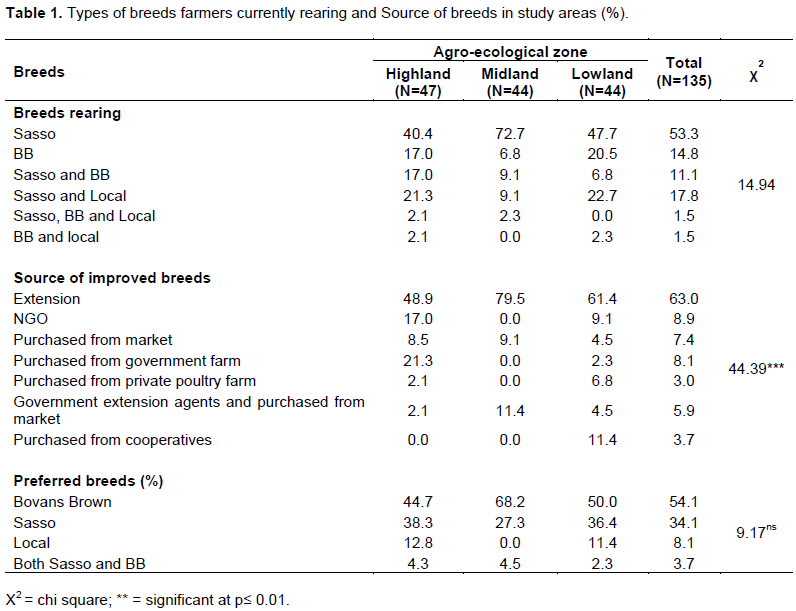
Government Extension agents, NGO, purchasing from market, purchasing from cooperatives and private farms were the major sources of improved chicken in the studied areas. Accordingly from a total of (135) interviewed 63% was provided through extension, 8.9% was provided by GOs and 7.4% were purchased from market in the form of pullets and cockerels on average in all agro-ecologies (Table 1). Around 3.7% of the respondents disclosed that they bought from cooperatives after their age of 45 days. The respondents indicated that they can obtain this breeds easily either by government side or by purchasing from locally organized cooperative and the private farm also gave them through credit. The implication of the current result is that in the absence of government source, there is no lack of the supply of Sasso breeds since the private farm (ethio-chicken poultry farm) gave to them through credit with or without the recognition of government.
Even though each breeds has its own advantages based on different traits mainly on egg production, body size and meat production, scavenging ability, disease resistance and physical appearances; across different agro-ecologies most of the farmers preferred Bovans brown (54.1%) in over all agro ecologies of the study areas followed by Sasso (34.1%) and local breeds (8.1%) (Table 1).
Trait preference of farmers
According to survey conducted farmers identify traits of preference mainly on egg production, body size and meat production, scavenging ability, disease resistance and physical appearance (Table 2). Accordingly 94.4% of respondents on average in all agro ecologies select Bovans brown (Appendix Table 2) for egg production while Sasso breed (Appendix Table 1) was selected by respondents (97.5%) for having large body size and producing high amount of meat. Even though low in production and productivity indigenous chicken (Appendix Table 3) was selected as high for having better egg taste (88.7%), producing chicks with high survival rate or good mothering ability (95.9%), scavenging ability (86.6%) and disease resistance (86.6%) traits. This result is in line with the report of Nigussie (2011) in which farmers in different part of Ethiopia mainly select adaptive traits, meat and egg test as their preferred traits. The most important traits of farmers in Jordan were growth rate, disease tolerance, egg yield, body size and fertility (Abdelqader et al., 2007). Majority of the farmers in Kenya considered egg yield as the most important trait followed by mothering ability and body size (Okeno et al., 2011). Identification of traits of economic importance is vital in the development of breeding objectives. Egg production/hen, age at first slaughter (meat yield) and diseases resistance were the farmer’s preferred traits to be improved in the study area (Vivian, 2011; Bihan, 2004).
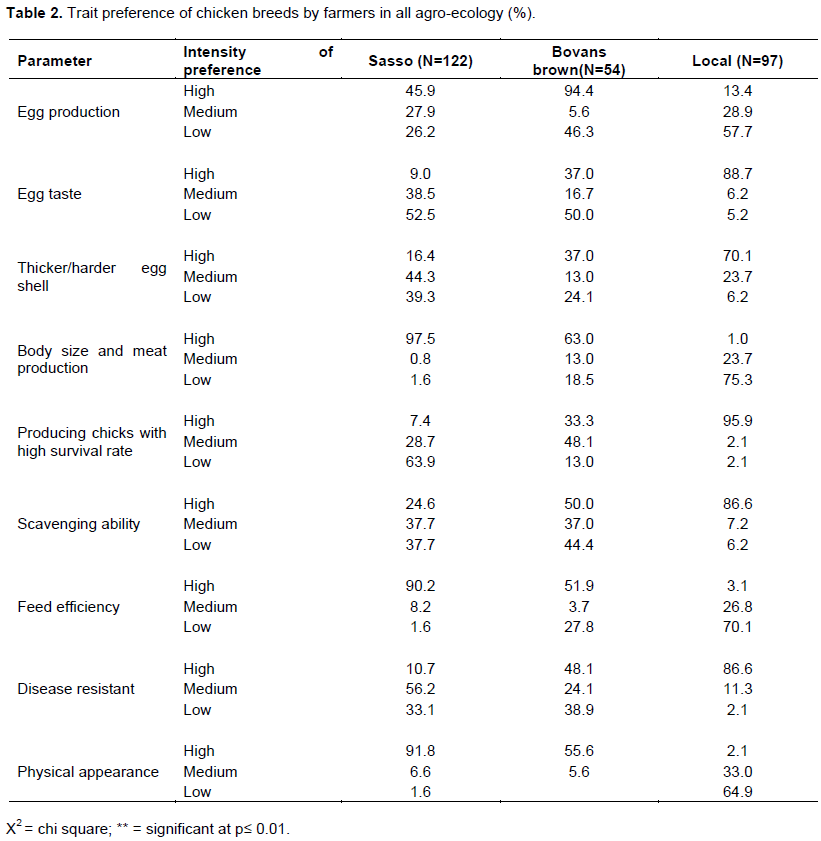

Breeds adaptability
Similar to a breed's demand for vaccination and susceptibility to disease, hardiness and adaptability also depend on origin. Average percent mortality for both breed is higher in lowland agro ecology (Table 3). But on average in three agro ecologies Bovans brown is better adaptive or less mortality until production phase. Poultry production is affected by factors such as breed and strain of chicken used, environmental conditions in poultry house, management practices and feed and feeding management (Bell and Weaver, 2002). Growth and production traits of a bird indicate its genetic constitution and adaptation with respect to the specific environment (Ahmed and Singh, 2007).
Cause of mortality
Cause of mortality for studied breeds (Sasso and Bovans brown) in the study areas were presented in Table 4. According to the respondents high cause of mortality is due to disease 20.2% for Sasso and 31% for Bovans brown followed by predators 11.9 and 13.8% for Sasso and Bovans brown respectively though there were significant difference (p<0.05) across agro-ecology for Sasso breeds. Under village poultry production, prevailing diseases, predators, lack of proper health care, poor feeding and poor marketing information were reported as constraint by Moges et al. (2010), Dinka et al. (2010) and Mengesha et al. (2011). The high mortality of chicks under village chicken production in the central highlands of Ethiopia is due to diseases, parasites, predation, lack of feed, poor housing and insufficient water supply (Tadelle, 2001).
Production and productivity of assessed breeds
The average production and reproduction performance of village chicken is shown in Table 5. The information collected on age at first laying disclosed that the mean ages at first laying were 5.9±1.5, 5.7±1 and 7.1±1.6 months for Sasso, Bovans brown and local breeds respectively. The result indicated that Bovans brown chicken breeds reach an age of egg production earlier than Sasso and local breeds which is attributed to breed type difference. This is one of the traits that attributes for the farmers to prefer Bovans brown than Sasso breeds. Birds that reach an age of egg production earlier are supposed to be more efficient on feed consumed (Teketel, 1986).
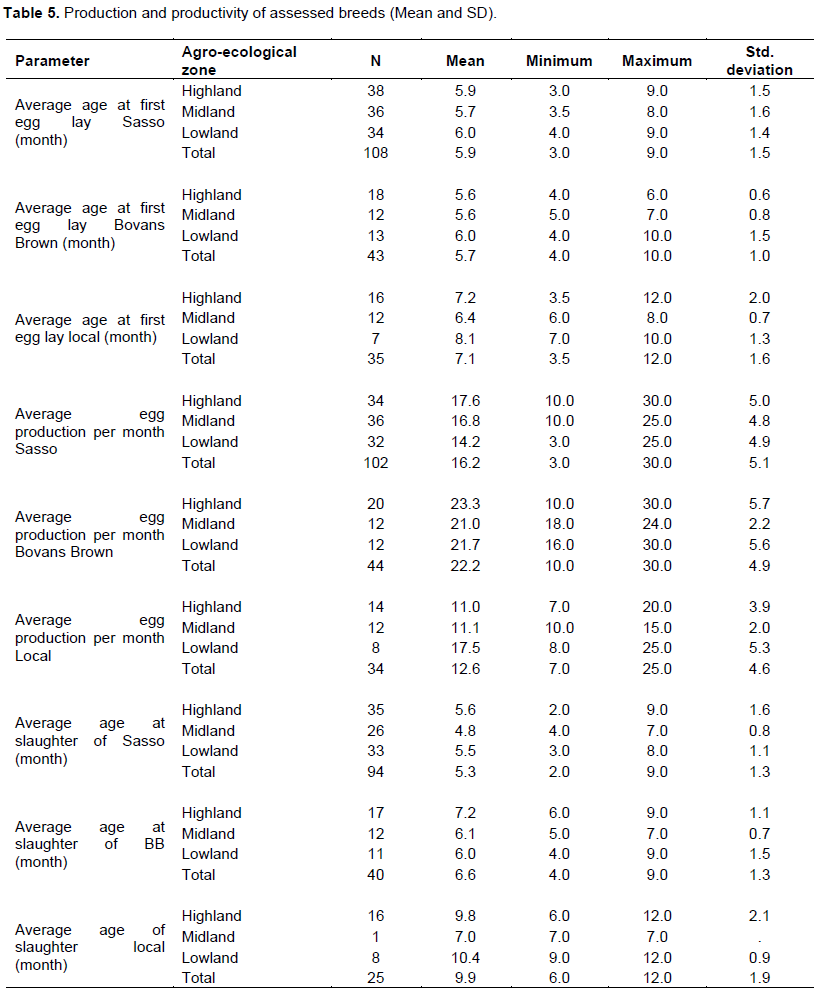
The average age at first egg laying of local chicken is in line with the result reported by Fisseha et al. (2010) which is 7 months in North West Ethiopia but shorter than Deneke et al. (2015) in South Eastern Oromia region of Ethiopia, Addisu et al. (2014) in North Wollo zone of Amhara region of Ethiopia and Solomon et al. (2013) North West Ethiopia, in Meketel Zone which are 5.48-6.50, 4.76 and 5.2±1.16, respectively. The current study revealed average first egg lay of Sasso breeds under farmers’ management condition is relatively later in age at first lay than the study of Desalew (2012) which reported 5.35 ± 0.45, 5.52 ± 0.44 and 5.11± 0.2 months for Isa Brown, Bovans Brown and Potchefstroom Koekoek respectively under village production system in East Shoa, Ethiopia.
The result in the current study revealed that the average egg production per month of Bovans brown (22.2) is higher than that of Sasso (16.2) and local chickens (12.6). The current result of egg production of Bovans Brown was in line with Dasalew (2012) reported for Bovans brown 266.32±8.7 but relatively lower and higher than 276.1±11.3 and 187.04±13.49, respectively, for Isa Brown and Potchefstroom Koekoek respectively under village production system in East Shewa, Ethiopia. According to the respondents, the average age of slaughter in all agro ecologies showed that Sasso (5.3±1.3 months) chicken breed earlier to reach slaughter than Bovans Brown (6.6±1.3 months) and local (9.9±1.9 months) chicken breeds. This indicates that Sasso seems to reach slaughter age earlier than Bovans brown and local chicken breeds.
Constraints of improved chicken production in study areas
Most respondents frequently mentioned feed shortage as the first ranked chicken production constraint in all districts (25.4%) whereas predators (20.1%) were the second and disease was the third constraints in overall agro ecologies though there were significant (p<0.05) differences among agro ecologies (Table 6). Due to these mentioned constraints, the farmers did not achieve sustainable improvements from the local and improved exotic breeds and/or the cross-breeds. Similar results were reported by different scholars at different parts of the country contrary or similar to the current reports on constraints of local or improved exotic and/or cross breed
chicken production under farmers management condition.
Fisseha (2009), Hassen (2007), Bogale (2008) and Addis et al. (2013) reported disease, predation, market system, management and production system were major constraints of chicken production in Ethiopia and identified diseases as the first ranked chicken production constraints in all districts whereas predators like snacks as the third problem in Tach Armachiho and Quara districts. Tadelle et al. (2001) also reported that high mortality of chicks due to diseases, parasites, predation, lack of feed, poor housing and insufficient water supply was the major constraints in village chicken production in the central highlands of Ethiopia. Similarly, Moges et al. (2010), Dinka et al. (2010) and Mengesha et al. (2011) under village poultry production reported prevailing diseases, predators, lack of proper health care, poor feeding and poor marketing information as major constraints.
Opportunities of improved chicken production in study areas
The major opportunities of improved chicken production in the study areas are presented in Table 7. Even if many constraints were raised by respondents in the study area there were also some opportunities to improve village chicken production and productivity for the future such as good government attention, breed availability, market availability and training and extension service. Good government attention was the primary opportunities (34.2%) for the sector improvement followed 10, 5 and 2.5% of opportunities for improved chicken production under farmers management condition breed availability, market access and chicken meat eating habits and presence of good credit and saving services respectively. Government emphasis towards the development of trained manpower, infrastructure (electricity, road etc.) and establishment of different institutions focusing on livestock sector especially the poultry sub-sector to enhance its contribution to country’s economy and food security were opportunities of chicken production in the country (EIAR, 2015).
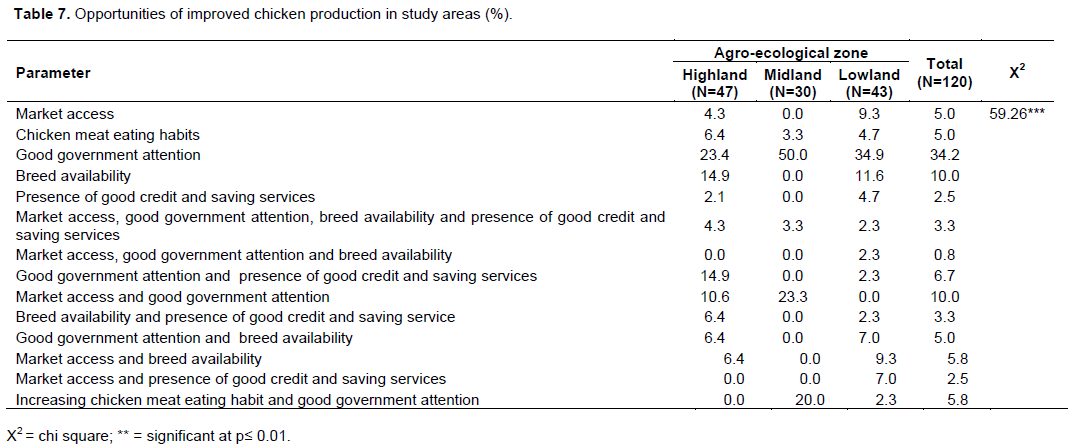
Better understanding of these constraints and good prospects of improved exotic and/or cross or local chicken production is important to improve food security and improves the standard of living condition of the farmers.
The result of the current survey indicated that the production and productivity of the Sasso chicken breed distributed by ethio-chicken private farms under farmer management condition is better than indigenous chicken. But lower than the Bovans brown breed interims of egg production, disease resistibility. Also scavenging ability, feed consumption egg taste of Bovans brown is better than Sasso following indigenous chicken. By these traits farmers in most study areas or agro-ecologies prefers Bovans brown breeds. However, by growth performance or body size development, Sasso breeds are relatively better than Bovans brown breeds. Therefore, for Sasso breed to conclude it is broiler or not further investigation is needed/should be done on station level before distribution. In addition to this, the Sasso breeds currently distributed to the farmers by the ethio-chicken private farms is the cross (F1) of SA51A (female) and T44 (male). Hence the breed general management, production and productivity, nutritional management and health guidelines were not known. To have a clear understanding of the performance of Sasso breeds, on-farm and on-station controlled experiment on management practices and feeding strategy is important.
The authors have not declared any conflict of interests.
REFERENCES
|
Abdelqader A, Wollny CBA, Gauly M (2007). Characterization of local chicken production systems and their potential under different levels of management practices in Jordan. Trop. Anim. Health Prod. 39:155-164.
Crossref
|
|
|
|
Addis G, Kefyalew A, Zewdu W (2013). Phenotypic characterization of indigenous chicken ecotypes in north Gondar Zone, Ethiopia. Glob. Vet. 12(3):361-368.
|
|
|
|
|
Addisu H, Zewdu W, Hailu M (2014). Breeding practice and objective of indigenous chicken in North Wollo, Amhara regional State, Ethiopia. Int. J. Livest. Prod. 5(1):15-22.
Crossref
|
|
|
|
|
Ahmed M, Singh P (2007). Estimates of genetic parameters for some economic traits in White Leghorn. Ind. Poult. Sci. 42:311-312.
|
|
|
|
|
Bell D, Weaver W (2002). Commercial Chicken Meat and Egg Production. 5th ed. Cambridge, Massachusetts. Kluwer Academic Publisher.
Crossref
|
|
|
|
|
Besbes B (2009). Genotype evaluation and breeding of poultry for performance under suboptimal village conditions, World's Poult. Sci. J. 65:260-271.
Crossref
|
|
|
|
|
Bihan D (2004). Genetic variability within and between breeds of poultry technological meat quality. World's Poult. Sci. J. 60:331-340.
Crossref
|
|
|
|
|
Bogale K (2008). In-situ Characterization of Local Chicken Eco-type for Functional Traits and Production System in Fogera District, Amhara regional state MSc Thesis Department of Animal Science School of Graduate Studies, Haramaya University, Haramaya, Ethiopia.
|
|
|
|
|
Delgado C, Rosegrant M, Steinfeld H, Ehui S, Courbois C (1999). Livestock to 2020; The next Food Revolution. Food, Agriculture and the Environment Discussion paper 28. Washington, DC, International Food policy Research Institute. pp. 57-59.
|
|
|
|
|
Deneke N, Aberra M, Sandip B (2015). Phenotypic characterization of indigenous chicken populations in Southeastern Oromia Regional State of Ethiopia. Anim. Genet. Resour. 55:101-113.
|
|
|
|
|
Desalew T (2012). Management practices, productive performances and egg quality traits of exotic chickens under village production system in East Shoa, Ethiopia. A thesis submitted to the school of Graduate Studies of Addis Ababa University, Debre Zeit, Ethiopia.
|
|
|
|
|
Dinka H, Regassa C, Fufa D, Endale B, Leta S (2010). Major Constraints and Health Management of Village Poultry Production in Rift Valley of Oromia, Ethiopia. Am. Eurasian J. Agric. Environ. Sci. 9(5):529-533.
|
|
|
|
|
Ethiopian Institute of Agricultural Research (EIAR) (2015). Livestock Research Process, Poultry Research Case Team, Fifteen years of National Research Strategy, Addis Ababa, Ethiopia.
|
|
|
|
|
FAO (2010). Poultry genetics and breeding in developing countries. Genetic diversity and conservation of genetic resources. Poultry development review by Robert Pym, Paper N° 5 Rome.
|
|
|
|
|
Fisseha M (2009). Studies on production and marketing system of local chicken ecotypes in BureWereda, North west Amhara M.Sc. Thesis, Hawassa University, Hawassa, Ethiopia.
|
|
|
|
|
Fisseha M, Aberra M, Tadelle D (2010). Assessment of village chicken production system and evaluation of the productive and reproductive performance of local chicken ecotype in Bure district, North West Ethiopia. Afr. J. Agric. Res. 5(13):1739-1748.
|
|
|
|
|
Gueye EF (2000). Approaches to family poultry development. Proceedings of 21st World Poultry Congress, Montreal, Canada, CD - ROM.
|
|
|
|
|
Hassen H (2007). Phonotypic and genetic characterization of indigenous chicken populations in Northwest Ethiopia PhD Thesis. National and agricultural sciences department of animal Wild life and Grassland Sciences University of the Free State, Bloemfontein, South Africa.
|
|
|
|
|
Mengesha M, Tamir B, Dessie T (2011). Village Chicken Constraints and Traditional Management Practices in Jamma District, South Wollo, Ethiopia. Livest. Res. Rural Dev. 23(2):37.
|
|
|
|
|
Moges F, Abera M, Tadelle D (2010). Assessment of village chicken production system and evaluation of the productive and reproductive performance of local chicken ecotype in Bure district, North West Ethiopia. Afr. J. Agric. Res. 5(13):1739-1748.
|
|
|
|
|
Muchadeyi FC, Eding H., Wollny CBA., Groeneveld E, MakuzaSM., Shamseldin R., Simianer H, Weigend S (2007). Absence of population sub-structuring in Zimbabwe chicken ecotypes inferred using microsatellite analysis, Anim. Genet. 38: 332-339.
Crossref
|
|
|
|
|
Nigussie D (2011). Breeding programs for indigenous chicken in Ethiopia: analysis of diversity in production systems and chicken populations PhD Thesis, Wageningen University, the Netherlands.
|
|
|
|
|
Okeno TO, Kahi AK, Peters KJ (2011). Breed selection practices and traits of economic importance for indigenous chicken in Kenya. Livest. Res. Rural Dev. 23:209.
|
|
|
|
|
Solomon D (2008). Ethiopia: Poultry sector country review. FAO, Rome, Italy.
|
|
|
|
|
Solomon Z, Binyam K, Bilatu A, Ferede A (2013). Village chicken production systems in Metekel zone, Northwest Ethiopia. Wudpecker J. Agric. Res. 2(9):256-262.
|
|
|
|
|
Tadelle D (2001). The role of scavenging poultry in integrated farming systems in Ethiopia. Debre Zeit Agricultural Research Center, Debre Zeit, Ethiopia. Livestock feed resources within 55 integrated farming systems. pp. 377-399.
|
|
|
|
|
Tadelle D, Kijora C, Peters K (2003a). Indigenous chicken ecotypes in Ethiopia: growth and feed utilization potentials. Int. J. Poult. Sci. 2:144-152.
Crossref
|
|
|
|
|
Tadelle D, Million T, Alemu Y, Peters K (2003b). Village chicken production systems in Ethiopia: 1. Flock characteristics and performance.Lives. Res. for Rural Dev. 15(1).
|
|
|
|
|
Teketel F (1986). Studies on the meat production potential of some local strains of chickens in Ethiopia. Geissen, Germany, J.L. University of Geissen, 186 p.
|
|
|
|
|
Vivian UO (2011). Estimation of genetic parameters and selection for egg production traits in a Nigerian local chicken ecotype. ARPN J. Agric. Biol. Sci. 6(12):54-57.
|
|
APPENDIX








